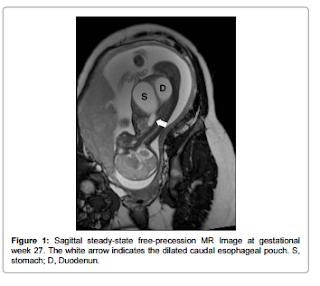Introduction
As fetal scanning is key to the diagnosis of various congenital
anomalies, prenatal ultrasound is widely used in obstetrical practice in Japan.
We encountered recently a pregnant woman with atypically enlarged and clear
double-bubble in the fetal abdomen. This case indicated that differential
diagnoses should include a rare anomaly of double atresia occurring in the
esophagus and proximal jejunum in fetuses with double-bubble sign.
Case Report
A 28-year-old nulliparous Japanese
woman presented with doublebubble sign in the fetal abdomen and
polyhydramnios on ultrasound study at gestational week (GW) 25. Atypically
enlarged and clear double-bubble with enlarged distal portion of the esophagus
on MRI study at GW 27 in the fetus suggested double atresia of the esophagus
and duodenum in this patient (Figure 1). Chromosomal analysis using amniotic
fluid obtained at amnioreduction at GW 33 for treatment of polyhydramnios
revealed normal male karyotype. An otherwise healthy infant was born vaginally
at GW 36 weighing 2794 g, but required tracheal intubation because of
insufficient respiration caused by the abdominal distension. He was diagnosed
as having double atresia, including jejunal atresia 3
cm distal to the ligament of Treitz and esophageal atresia. The distance
between the esophageal pouches was less than 1 cm and there was no
tracheoesophageal fistula (TEF). These were surgically repaired at 1 and 36
days of age, respectively. The patient left hospital at 69 days of age with an
uneventful postoperative course.
Discussion
To our knowledge, there have been no reports on double atresia
involving the esophagus and jejunum showing double-bubble sign. The
double-bubble sign, originally described on plain radiography, but now also
appreciable on ultrasound and MRI, is a result of excessive fluidfilled
structures in the abdomen. Therefore, double-bubble sign is seen prenatally in
fetuses with various alimentary tract pathologies . Although the most frequent
pathology for the double-bubble sign is duodenal stenosis/atresia , it is not
exclusively pathognomonic for duodenal atresia. Pathologies other than duodenal
stenosis/atresia presenting with a double-bubble sign include cystic biliary
atresia, colonic duplication, malrotation with midgut volvulus, and triple gut
atresia.

No comments:
Post a Comment